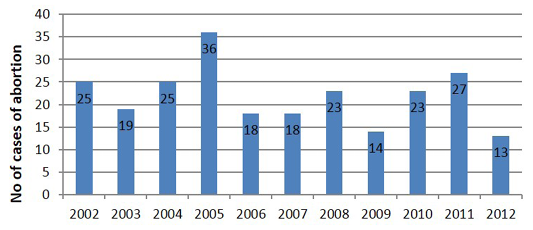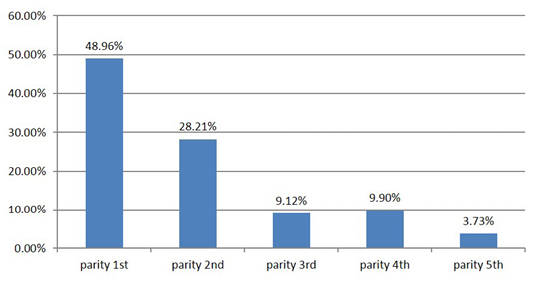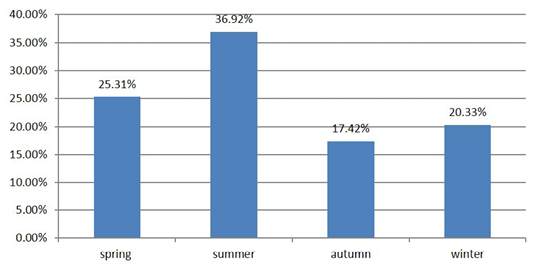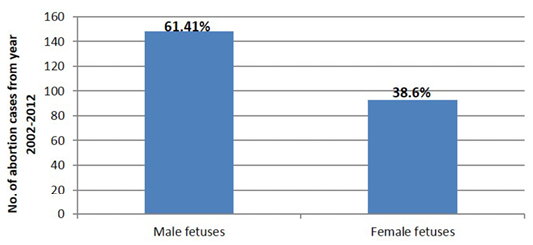Advances in Animal and Veterinary Sciences
Research Article
Effect of Parity of Animal, Season and Sex of Fetus on the Rate of Abortion in Dairy Cattle
Bhat Yaqoob*, Sharma Mridula, Singh Anoop
Department of Veterinary Gynaecology and Obstetrics, College of Veterinary and Animal sciences, GB Pant University of Agriculture and Technology, Pantnagar-263145, Uttarakhand, India.
Abstract | A survey was done at IDF Nagla, Pantnagar, Uttarakhand from year 2003 to 2012 to observe the effect of season, parity of the animal and sex of fetus on the rate of abortion in dairy cattle. All the cases of abortion in dairy cattle were recorded and analysis of data was conducted to determine the link between season, parity and sex of fetus on rate of abortion. The total number of abortions in dairy cattle were 241. Sex of 148 fetuses aborted was male and 93 aborted were females. The no of abortion in first parity animals were 118 (maximum) and 68 second parity, 22 in 3rd parity, 24 in 4th parity, 9 in 5th parity .Maximum number of abortions were recorded during the summer time (89). 61 cases of abortion were recorded in spring, 49 cases of abortion in winter and 42 cases in autumn.
Keywords | Effect of season, Parity, Sex, Rate of abortion, Dairy cattle
Editor | Kuldeep Dhama, Indian Veterinary Research Institute, Uttar Pradesh, India.
Received | October 03, 2016; Accepted | October 20, 2016; Published | November 05, 2016
*Correspondence | Bhat Yaqoob, Department of Veterinary Gynaecology and Obstetrics, College of Veterinary and Animal sciences, GB Pant University of Agriculture and Technology, Pantnagar-263145, Uttarakhand, India; Email: bhatyaqoob996@gamil.com
Citation | Yaqoob B, Mridula S, Anoop S (2016). Effect of parity of animal, season and sex of fetus on the rate of abortion in dairy cattle. Adv. Anim. Vet. Sci. 4(11): 571-574.
DOI | http://dx.doi.org/10.14737/journal.aavs/2016/4.11.571.574
ISSN (Online) | 2307-8316; ISSN (Print) | 2309-3331
Copyright © 2016 Yaqoob et al. This is an open access article distributed under the Creative Commons Attribution License, which permits unrestricted use, distribution, and reproduction in any medium, provided the original work is properly cited.
Introduction
Abortion in dairy cattle is commonly defined as loss of the fetus between the age of 42 days and approximately 260 days (Hovingh, 2002). Pregnancies lost before 42 days are usually referred as embryonic deaths, whereas a calf that is born dead between 260 days and full term is defined as still birth (Jousan et al., 2005) a low rate of abortion is usually observed on farms and 3 to 5 abortion in 100 pregnancy per year is often considered as” normal” (Hovingh, 2002). However, the loss of any pregnancy can represent a significant loss of (potential) income to the producer and appropriate action should there for be taken to prevent abortion and to investigate the cause of abortion that may occur (Forar et al., 1996). Each abortion is estimated to cost of producer $500 to $900-depending on such factors as a current value of replacement stock, feed and milk prices and the stage gestation when the abortion occur.
The diagnosis of abortion often presents challenges to vet. Although a gradual increase in abortion rate in herd may be noted over a period of many years, a sudden and dramatic increase is more commonly seen (Howard and Smith, 1999). For this reason, prompt action is required when abortion do occur. Well-kept records would be beneficial investigation of abortion problems.
Since India is developing country in which more than 50% population makes their livelihood on agricultural based activity. With increased awareness the people are shifting from agricultural activities to dairy business. With the modernization of dairy business, many problems are encountered in dairy business which seriously limits the net profit. Abortion being one of the leading factor in limiting the profits in the dairy business, should be limited to its minimum. Any case of abortion in dairy farm should be closely and thoroughly investigated to determine the cause and to safeguard the rest animal from the possible threat.
Material and Methods
Our research was based on data collection, the data during 2003-2012 was taken from record book maintained at the office of the Instructional Dairy Farm Nagla, GBPUAT, Pantnagar. Data was analyzed and simple statistics was applied to derive the results.
Results
Effect of parity of animal, season and sex of fetus on the rate of abortion in dairy cattle is depicted in Figure 1, 2, 3 and 4.

Figure 1: Number of abortions in different years
In year 2002, the total cases of abortion recorded at IDF Nagla were 25. 64 %male fetuses (16 in number) and 36% female fetal abortions (9 in number) were recorded. 9 animals (36%) aborted in first parity, 11 animals (44%) aborted in second parity, 1 animal (4%) aborted in third parity, 3 animals (12%) aborted in fourth parity, and 1 animal (4%) aborted in fifth parity.

Figure 4: Effect of parity on rate of abortion
In year 2003, the total cases of abortion recorded at IDF Nagla were 19. 57% male fetuses (11 in number) and 42% female fetal abortions (8 in number) were recorded. 6 animals (31.5%) aborted in first parity, 9 animals (47.3%) aborted in second parity, 1 animal (5.2%) aborted in third parity, 2 animals (10.5%) aborted in 4th parity and 1 animal (5.2%) aborted in 5th parity.
In year 2004, the total cases of abortion recorded at IDF Nagla were 25. 68% male fetuses (17 in number) and 32% female fetal abortions (8 in number) were recorded. 14 animals (56%) aborted in first parity, 5 animals (20%) aborted in second parity, 3animal (12%) aborted in third parity, 3 animals (12%) aborted in 4th parity and 0 animal (0%) aborted in 5th parity.
In year 2005, the total cases of abortion recorded at IDF Nagla were 36. 55.55% male fetuses (20 in number) and 44.44 % female fetal abortions (16 in number) were recorded. 27 animals (58.30%) aborted in first parity, 7 animals (19.44%) aborted in second parity, 5animal (13.88%) aborted in third parity, 0 animals (0%) aborted in 4th parity and 3 animal (8.33%) aborted in 5th parity.
In year, 2006 the total cases of abortion recorded at IDF Nagla were 18. 66.66% male fetuses (12 in number) and 33.33 % female fetal abortions (6 in number) were recorded. 10 animals (55.30%) aborted in first parity, 4 animals (22.22%) aborted in second parity, 2 animals (11.11%) aborted in third parity, 2 animals (11.11%) aborted in 4th parity and 0 animals (0%) aborted in 5th parity.
In year 2007, the total cases of abortion recorded at IDF Nagla were 18. 55.55% male fetuses (10 in number) and 44.44 % female fetal abortions (8 in number) were recorded. 6 animals (33.33%) aborted in first parity, 5 animals (27.27%) aborted in second parity, 3 animals (16.66%) aborted in third parity, 4 animals (22.22%) aborted in 4th parity and 0 animals (0%) aborted in 5th parity.
In year 2008, the total cases of abortion recorded at IDF Nagla were 23. 69.56% male fetuses (16 in number) and 30.43 % female fetal abortions (7 in number) were recorded. 14 animals (60.86%) aborted in first parity, 6 animals (26.08%) aborted in second parity, 1 animals (4.3%) aborted in third parity, 1 animals (4.3%) aborted in 4th parity and 1 animals (4.3%) aborted in 5th parity.
In year 2009, the total cases of abortion recorded at IDF Nagla were 14. 64.28% male fetuses (9 in number) and 35.71 % female fetal abortions (5 in number) were recorded. 8 animals (57.14%) aborted in first parity, 4 animals (28.57%) aborted in second parity, 1 animal (7.14%) aborted in third parity, 1 animals (7.14%) aborted in 4th parity and 0 animals (0%) aborted in 5th parity.
In year 2010, the total cases of abortion recorded at IDF Nagla were 23. 56.52% male fetuses (13 in number) and 43.47 % female fetal abortions (10 in number) were recorded. 12 animals (52.17%) aborted in first parity, 6 animals (26.08%) aborted in second parity, 3 animals (13.04%) aborted in third parity, 1 animal (4.34%) aborted in 4th parity and 1 animal (4.34%) aborted in 5th parity.
In year 2011, the total cases of abortion recorded at IDF Nagla were 27. 59.25% male fetuses (16 in number) and 40.74 % female fetal abortions (11 in number) were recorded. 12 animals (44.44%) aborted in first parity, 8 animals (29.62%) aborted in second parity, 2 animals (7.4%) aborted in third parity, 4 animals (14.81%) aborted in 4th parity and 1 animal (3.7%) aborted in 5th parity.
In year 2012, the total cases of abortion recorded at IDF Nagla were 13. 61.53% male fetuses (8 in number) and 38.46 % female fetal abortions (5 in number) were recorded. 6 animals (46.15%) aborted in first parity, 3 animals (23%) aborted in second parity, 0 animals aborted in third parity, 3 animals (23%) aborted in 4th parity and 1 animal (7.6%) aborted in 5th parity.
From the period of 2002 to 2012, the total cases of abortion recorded at IDF Nagla were 241. 61.41% male fetuses (148 in number) and 38.6% female fetal abortions (93 in numbers) were recorded. 118 animals (48.96%) aborted in first parity, 68 animals (28.21%) aborted in 2nd parity, 22 animals (9.12%) aborted in 3rd parity, 24 animals (9.9%) aborted in 4th parity and 9 animals (3.73%) aborted in 5th parity. 25.31% (61 in number) cases of abortion were recorded in spring. 36.92% (89 in number) cases of abortion were recorded in summer. 17.42% (42 in number) cases of abortion were recorded in autumn. 20.33% (49 in number) cases of abortion were recorded in winter.
Discussion
Seasonal Effects
A higher frequency of abortion was observed in cows during summer season whereas, cows during autumn season had the smallest probability of abortion as depicted by above results. In contrast, Labernia et al. (1996) reported higher rate of abortion for cows which were inseminated in autumn. It is worth mentioning that Lopez-Gatius et al. (2004) did not report any significant effect of season of insemination on pregnancy loss. In summer the risk of abortion is higher than other seasons mainly due to heat stress. Other reasons that elevate the probability of abortion in this season include glandular function, ratio and infectious agent (Hovingh, 2002). He also reported that heat stress can affect reproductive performance in a dairy herd, although it will generally cause conception problems rather than abortions.
Sex of Fetus
The data reveals the significant difference between the sexes of aborted fetuses. Abortions with male sex fetus are higher (61.41%) than abortions with female sex fetus (38.6%). According to Al-Samarai et al. (2012), only the season and year of calving have significant effects whereas the effect of sex of aborted fetus is not significant. Similar results were obtained by different researchers including, Fisher (1979), Osei et al. (1991) and Roche et al. (2006). Our study and above data is in contrast to findings studied by these researchers.
Parity
The above data reveals that maximum incidence of abortion in dairy cattle occurs in first parity. From first parity onwards the incidence of abortion in cows decreases. Our study however is in contrast to study done by Markusfeld-Nir (1997) who reported higher pregnancy losses in multi-parous cows. The elevated risk of abortion at higher ages in cattle is similar to humans, which is dependent on parity (Skjærven and Klungsøyr, 2007). The main reason for higher incidence of abortion in primiparous cows could be that the primiparous cows are remains in negative energy balance (Ghorbani and Asadi-Alamoti, 2004). They lose weight during this period which can cause a reduction in body condition score with a corresponding negative correlation with progesterone secretion & would be harmful to fetal survival (Spicer et al., 1990; Grimard et al., 2006).
Conclusion
By analyzing data, the rate of abortion is more common in primiparous animals which are followed by the animals in 2nd parity. Maximum incidence of abortions occurs in summer season and minimum in autumn season. The rate of abortion is more with male fetus than female fetuses.
Acknowledgement
We are highly thankful and obliged for assistance and support provided by Dean, College of Veterinary sciences, GBPUAT, Pantnagar and Director, Instructional Dairy Farm Nagla for the present survey. we wish to express my gratitude to Mr. Sharma ji who is in charge of the record keeping unit at IDF Nagla for his cooperation in providing data for this study.
conflict of interest
There is no conflict of interest. The results are in accordance with the opinion of authors.
authors’ contribution
All authors contributed technically in carrying out this research and finalizing this article.
References







